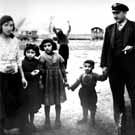
|
|
|

|

|

|

|
|
Click on an image to see a larger, more detailed picture.
|
|
|
|
|
| 1943: Death and Resistance |

|
pg. 452 |

|
|
|
|
| |
 Jürgen Stroop
Jürgen Stroop
General Jürgen Stroop gained notoriety for brutally suppressing the Warsaw Ghetto uprising of April-May 1943. In recognition of his services to the Third Reich, Stroop was awarded the Iron Cross First Class. In April 1943 Stroop (pictured, left) was ordered to remove the remaining 56,000 Jews from Warsaw and to crush the revolt that had recently broken out. He approached the task with ruthless efficiency. More than 2000 SS and army units descended upon the ghetto and systematically destroyed it building by building. His detailed report of his activities attests to his cold-blooded callousness. On May 16 Stroop reported that the "operation" was complete and that "the Jewish Quarter of Warsaw is no more." Stroop was sentenced to death by a Polish court of law and executed on September 8, 1951.
Photo: Bildarchiv Preussischer Kulturbesitz / United States Holocaust Memorial Museum Photo Archive
|
 A Finnish battalion of the Waffen-SS returns home from action on the Soviet front. This Freiwillige (volunteer) unit was one of the many non-German groups that joined the Waffen-SS. Their anti-Russian attitudes were exploited by the Nazi regime for the benefit of both the war effort and facilitation of the "Final Solution."
A Finnish battalion of the Waffen-SS returns home from action on the Soviet front. This Freiwillige (volunteer) unit was one of the many non-German groups that joined the Waffen-SS. Their anti-Russian attitudes were exploited by the Nazi regime for the benefit of both the war effort and facilitation of the "Final Solution."
Photo: SYddeutscher Verlag Bilderdienst
|
 A family interned in the Marzahn Gypsy camp in Germany awaits its fate. Large-scale deportations to Auschwitz began in February 1943, when a "family camp" for Gypsies was established at the Birkenau killing center. The appalling conditions condemned thousands to death, while Josef Mengele conducted ghastly "medical experiments" on Gypsy twins.
A family interned in the Marzahn Gypsy camp in Germany awaits its fate. Large-scale deportations to Auschwitz began in February 1943, when a "family camp" for Gypsies was established at the Birkenau killing center. The appalling conditions condemned thousands to death, while Josef Mengele conducted ghastly "medical experiments" on Gypsy twins.
Photo: Bundesarchiv / United States Holocaust Memorial Museum Photo Archive
|
|

|

|

|

|
 May 12, 1943: Seventeen-year-old Frania Beatus, active in the Warsaw Ghetto underground, commits suicide rather than surrender to the Nazis.
May 12, 1943: Seventeen-year-old Frania Beatus, active in the Warsaw Ghetto underground, commits suicide rather than surrender to the Nazis.
|
 May 12, 1943: In London, Polish Jew Samuel Artur Zygelbojm, a key figure in the prewar Jewish Social Democrat Party, commits suicide following nearly a year of fruitless campaigning on behalf of Jews trapped in the Warsaw Ghetto, including his wife and teenage son. His death is reported in the press, which pointedly omits the text of his suicide note, which condemns the Allies for their indifference to the Jews.
May 12, 1943: In London, Polish Jew Samuel Artur Zygelbojm, a key figure in the prewar Jewish Social Democrat Party, commits suicide following nearly a year of fruitless campaigning on behalf of Jews trapped in the Warsaw Ghetto, including his wife and teenage son. His death is reported in the press, which pointedly omits the text of his suicide note, which condemns the Allies for their indifference to the Jews.
|
 May 13, 1943: Hans Frank, governor-general of Occupied Poland, sends SS Chief Heinrich Himmler a list of personal goods and valuables stolen from Jews. Among the booty are 25,000 fountain pens and 14,000 pairs of scissors.
May 13, 1943: Hans Frank, governor-general of Occupied Poland, sends SS Chief Heinrich Himmler a list of personal goods and valuables stolen from Jews. Among the booty are 25,000 fountain pens and 14,000 pairs of scissors.
|
|
|
|
|
| 1943: Death and Resistance |

|
pg. 452 |

|
|
The Holocaust Chronicle
© 2009 Publications International, Ltd.
|
|
